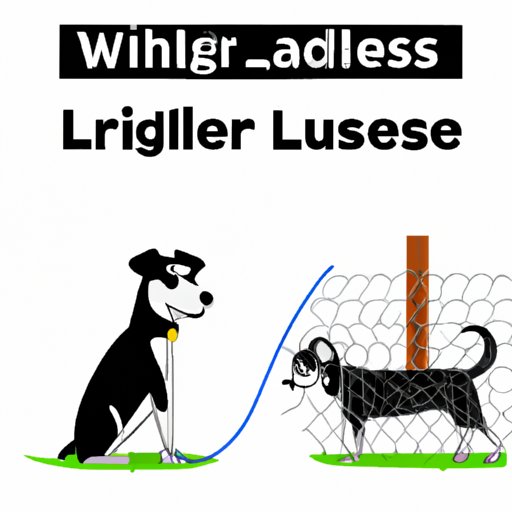Exploring How Does a Wireless Dog Fence Work
As dog owners, we all want to provide our pets with the freedom to run and play while keeping them safe and secure. One solution is to install a traditional fence, but that can be expensive, time-consuming, and in some cases, not even permitted. Luckily, there is an alternative option that’s gaining popularity among pet owners – a wireless dog fence. In this article, we’ll explore how a wireless dog fence works, its benefits, myths and misconceptions, and practical tips and advice for using it effectively.
Explaining the Science Behind a Wireless Dog Fence
Wireless dog fences are designed to keep your pet within a designated boundary without the need for a physical fence. The system uses radio signals to communicate with the dog’s collar and trigger an alert if he tries to exit the designated area.
The system consists of two main components: the transmitter, which is typically placed indoors, and the receiver, which is attached to your pet’s collar. The transmitter emits a radio signal that creates a circular boundary, and the receiver on your dog’s collar communicates with the transmitter to determine the pet’s distance from the boundary.
When your dog approaches the boundary, the receiver emits a warning beep, indicating to your pet that he’s nearing the boundary. If he continues to approach the boundary, he’ll receive a mild electric shock that’s designed to redirect him back to the safe area. This type of shock is very similar to what you’d experience when you touch a doorknob after rubbing your feet on the carpet.
The Benefits of a Wireless Dog Fence
One of the biggest benefits of a wireless dog fence is that it provides your pet with more freedom while keeping him safe at the same time. Dogs have a natural instinct to explore and run around, and a traditional fence can limit their movement and activity.
Another advantage of a wireless fence is the cost and time savings. A traditional fence can cost thousands of dollars to install, and it may take several days to complete the installation process. In contrast, a wireless fence can be installed within a couple of hours at a fraction of the cost of a physical fence.
Additionally, a wireless fence doesn’t obstruct your view or take up any backyard space, making it a perfect option for pet owners who want an aesthetically pleasing exterior. Moreover, wireless dog fences can be used indoors or outdoors, making them a versatile option for pet owners with different living situations or preferences.
Many pet owners have experienced how their pets have benefited from using the wireless dog fence. These fences have proven to be safe and effective in keeping pets within the designated boundaries while also promoting physical activity and exploration.
Personal Experiences with a Wireless Dog Fence
As a pet owner, I’ve had personal experience using a wireless dog fence with my dog, Bella. Before installing the fence, I was worried about how Bella would react to the shock and whether the system would be effective in keeping her contained. But after a brief training period, she quickly learned the boundaries and hasn’t had any issues since then.
I also appreciated the convenience and ease of installation. I didn’t have to worry about digging up my garden or disturbing the lawn by installing a physical fence. The wireless fence also provides me with peace of mind knowing that Bella is safe and secure in our yard.
Practical Tips and Advice for Using a Wireless Dog Fence
When considering a wireless dog fence, keep in mind the size and temperament of your dog. Large, highly energetic breeds may require more extensive training to get used to the system. Moreover, there are a few best practices you should follow when training your pet to use the fence effectively:
- Read the manufacturer’s instructions carefully and follow them precisely.
- Train your pet to respond to the warning beep before using the shock feature.
- Use caution when adjusting the intensity of the shock to avoid causing any harm to your pet.
- Regularly check the batteries to ensure that the system is functioning correctly and replace them as needed.
- Spend quality time with your pet in the yard and use the wireless fence as a tool to play rather than a mechanism for punishment.

Myths and Misconceptions about Wireless Dog Fences
There are several common myths and misconceptions surrounding wireless dog fences. Some people believe that these fences are inhumane or harmful to pets, but this is not true. The shock delivered by the collar is a mild correction that serves to direct the pet back to the safe area.
Others believe that wireless dog fences are unreliable and not worth the investment. However, advances in technology have made these fences much more reliable in recent years. With proper installation and training, wireless dog fences can provide a safe and effective solution for pet owners who want to give their pets more freedom.
Conclusion
Wireless dog fences are a great alternative to traditional fences. They provide your pet with the freedom to explore while keeping him safe and secure, and they do not obstruct your view or take up any space. By understanding how these fences work, we can make an informed decision on whether a wireless dog fence is the right choice for our pets. With proper installation, training, and usage, a wireless dog fence can be a game-changer for pet owners who want to maintain a safe and healthy environment for their furry friends.
(Note: Is this article not meeting your expectations? Do you have knowledge or insights to share? Unlock new opportunities and expand your reach by joining our authors team. Click Registration to join us and share your expertise with our readers.)
